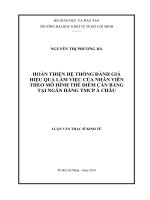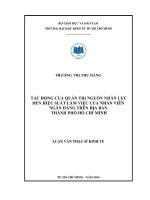Mối quan hệ giữa trí tuệ cảm xúc, phong cách lãnh đạo và hiệu suất làm việc của nhân viên
Bạn đang xem bản rút gọn của tài liệu. Xem và tải ngay bản đầy đủ của tài liệu tại đây (181.88 KB, 27 trang )
Southern Luzon State University
Thai Nguyen University
Republic of Philippines
Socialist Republic of Vietnam
THE DISERTATION OF DBA
THE RELATIONSHIPS AMONG EMOTIONAL INTELLIGENCE,
LEADERSHIP STYLES AND PERFORMANCE OF EMPLOYYEES IN
ENTERPRISES IN HANOI, VIETNAM
Name of Student
: Nguyen Thi Thu Huong
English Name
: Alice
Date of Birth
i
: 13/02/1977
Course
: SLSU-DBA1
2012
ABSTRACT
This study aims to determine the effect of leadership styles and emotional intelligence on
employee performance. The subjects of this study include 375 leaders and 730 subordinates in
enterprises in Hanoi, Vietnam. The questionnaire has two parallel forms, one for the leaders to
rate themselves and another in which subordinates can rate owns performance and
leadership styles, emotional intelligence of their leaders. Leadership styles and emotional
intelligence were identified as the independent variables and employee performance as the
dependent variable. Data obtained from each of the research instruments was then
statistically analysed. Through linear regression analysis it was concluded that there is a
significant relationship between leadership styles and employee performance, However, only
three leadership styles: the transactional leadership, the transformational leadership and the
charismatic leadership was seen to have a positive effect on the significant subscales of
employee performance and a visionary leadership has no significant effect on employee
performance. Simple correlation
analysis
showed
that
there
is a positive significant
linear relationship between emotional intelligence and employee performance. Moreover, this
results showed that a combination of the various leadership styles and emotional intelligence of
the leader will bring more effective and enhance employee performance. However, out of four
leadership styles, the visionary leadership combine leader’ emotional intelligence has negative
effect on employee.
Finally, although emotional intelligence and leadership styles had a significant effect on
employee performance, the emotional intelligence, charismatic leadership were affected more
ii
than others.
This research therefore adds a new dimension to employee performance, leadership styles
and emotional intelligence, since no similar study has been conducted.
As this research takes
place in the Vietnam context, the findings of this study were expected to provide references to a
corporate body in operating the human resource management strategy and developing the
leadership style.
iii
ACKNOWLEDGEMENTS
Firstly, I am deeply indebted to Dr. Adwin Bernal and sincerely grateful for your infinite
patience, direction, support, wisdom, and guidance throughout the research
Additionally, I would like to thank the following individuals for their contributions and
cooperation throughout the research:
•
All the leaders and employees who took the time to complete the questionnaires.
• Dr Nguyen Thanh Hai and Trinh Thi Hieu, from the International training center of
Thai nguyen University, for their help and assistance with the research.
•
My colleagues in The University of Labour and Social Affair, for their continuous
encouragement and support through the good and bad times, and also for helping with the
proofreading of the document
Finally, Many thanks and much appreciation to my family members and friends who both
supported and encouraged me throughout this process.
iv
Contents
ABSTRACT.................................................................................................................................... ii
ACKNOWLEDGEMENTS........................................................................................................... iv
LIST OF TABLES........................................................................................................................ vii
CHAPTER I: INTRODUCTION................................................................................................... 1
1. Background of the study ................................................................................................... 1
2. Statement of Objectives .................................................................................................... 4
3. Statement of the Problem ................................................................................................. 4
4. Hypotheses.......................................................................................................................... 5
5. Significance of the study ................................................................................................... 5
6. Scope and Limitations of the Study ................................................................................. 6
CHAPTER II: REVIEW OF RELATED LITERATURE AND STUDIES................................... 9
2.1.Leadership .......................................................................................................................... 9
2.2. Emotional intelligence ..................................................................................................... 18
2.3.Employee performance.................................................................................................... 23
2.4. Relationship between employee performance, leadership and emotional intelligent .......... 30
CHAPTER III: RESEARCH METHODOLOGY........................................................................ 36
3.1. Research design................................................................................................................ 36
3.2. Population and Sample ................................................................................................... 37
3.3. Measuring Instruments Used......................................................................................... 37
3.5. Data gathering procedure .............................................................................................. 39
v
3.6. Statistical Analysis .......................................................................................................... 40
CHAPTER IV: RESULTS AND DISCIUSSIONS...................................................................... 45
4.1. The Survey Respondents.................................................................................................. 45
4.2. Relationship Between Leadership Styles and Employee Performance...................... 46
4.3. Relationship Between Employee Performance and Leaders’ Emotional................... 49
4.4. Relationships among Emotional Intelligence, Leadership Styles and........................ 53
4.5. Most Effective Leadership Style in Vietnamese Companies ....................................... 54
CHAPTER 5: SUMMARY OF FINDINGS, CONCLUSION AND RECOMMADATIONS .... 56
5.1. Summary of Findings ...................................................................................................... 56
5.2. Conclusion ........................................................................................................................ 58
5.3. Recommendations ............................................................................................................ 59
5.3.1.Recommendations for the leaders................................................................................ 59
5.3.2.Recommendations for the enterprises .......................................................................... 60
5.3.3.Recommendations for future researchers .................................................................... 61
APPENDIXES .............................................................................................................................. 62
Appendix G: ........................................................................................................................... 78
Appendix H: ........................................................................................................................... 79
Appendix I: ............................................................................................................................. 80
Appendix K: Covariance Matrix ...................................................................................... 87
List of References.......................................................................................................................... 90
vi
LIST OF TABLES
Table 4.1: Sample and Response Rates…………………………………………………45
Table 4.2. The Distribution of the Participants in Terms of Gender……………………..46
Table 4.3. Leadership Style Survey – Item Descriptions…………………………………47
Table 4.4: Means and standard deviations of leadership style……………………………48
Table 4.5. Emotional intelligence Survey – Item Descriptions……………………………50
Table 4.7: Means and standard deviations of employee performance……………………52
Table 4.12. Correlations between Emotional Intelligence and Employee performance….55
vii
CHAPTER I: INTRODUCTION
1. Background of the study
In the global competitive market of today, Human Resources are playing a vital role in
almost all aspects of life and in organizational development. As more and more organizations
are making progress, by making the use of human resources, they need some means to
increase the performance in human resource by increasing the efficiency of leaders and
their followers. Emotional Intelligence is playing the vital role in the performance of
the leaders. T.Quang & N.T.Vuong (2002) state that management styles are profoundly
influenced by the social cultures in which organisations operate. It is important to identify the
most suitable style of management to the specific operating circumstances of an organisation.
This research investigates the relationships among employee performance, leadership styles
and emotional intelligence in enterprises in Hanoi, Vietnam.
To understand clearly that relationships, there is a need to consider some features of the
Vietnamese culture. Vietnam has a deep cultural heritage, which was developed over 4,000
years. However, Vietnam’s history is characterized by turbulence due to centuries of foreign
invasions and occupations. The northern part of Vietnam was strongly influenced by the
Chinese culture due to 1,000 years of dominance of the Chinese feudalism.
In general, the Vietnamese people are hospitable and industrious. The history and
geographic vicinity meant that Vietnamese people share many of the cultural and business
practices of their Chinese neighbours. In the words of Hofstede (1980), the Vietnamese
culture can be described as high power distance, high collectivism, moderate uncertainty
avoidance, and high context (Swierczek, 1994, Quang, 1997; Ralston et al., 1999).
1
The high power distance characteristic is present in the daily life of Vietnamese as well
as in business. In the family, sons and daughters have to obey parents’ orders. In
organisations, there is a clear subordinate-superior relationship. Titles, status, and formality
are very important in Vietnamese society. Collectivism has existed for a very long time in
Vietnam. It is characterised by tight social frameworks and self-functioning communities.
People expect ‘in groups’ to look after their members to protect them, and provide them with
security in return for their loyalty. Vietnamese people place importance on fitting in
harmoniously and avoiding losing the other’s face. In conflicts, they prefer to come out with a
win-win situation. Vietnamese culture displays moderate uncertainty avoidance. People in
society feel threatened by ambiguous situations and try to avoid these situations by providing
greater job stability, establishing more formal rules, and rejecting deviant ideas and
behaviour. One of the distinctive features in the Vietnamese society is indirect speech,
resulting from the importance of saving face. In compensation, the Vietnamese have a very
good sense of humour that surfaces often in every opportunity and conversation.
In economy, Vietnam is a nation in transition and a country full of opportunities. It has a
large, young, dynamic and highly literate population that has potential to be developed as a
resource to attain high levels of sustained economic growth (Quang, 2006). Before 1986,
Vietnam was a command economy dominated by large bureaucratic state-owned enterprises
(SOEs), an inefficient agricultural base and small family businesses. Vietnam started a
profound economic reform in 1986 that aimed to transform the country from a command
economy into market oriented economy called Doi moi.
As a consequence, Vietnam has substantially elevated its economy and the living
standards of Vietnamese people. The country reaped average economic growth rate (GDP) of
2
over 7% during the 1990s and early 2000s, especially more than 8% in 2006, which made
it one of the highest growing economies in the World (World Bank, 2006).
Excessive reliance on factor accumulation to support rapid growth is bound to be
unsustainable. There is a limit to how fast factors can grow to support a rapidly growing
economy. Although Vietnam has a large population base, people with necessary education
and skill to work in industry and services are getting increasingly scarce. This has led the
SEDP to identify skills and human capital as one of the breakthroughs for the next five years.
At the same time, rapid growth in credit, which is the basis for brisk growth in capital
accumulation, has led to macroeconomic instability, forcing the government to pursue a
tighter monetary policy in recent year.
Another sign of weakness in Vietnam’s economy is its persistent macroeconomic
instability. For four years in a row, Vietnam has had one of the highest inflation rates in Asia,
averaging nearly 16 percent a year between 2008 and 2011. Along with high inflation,
Vietnam has also been coping with persistent pressure on its currency, falling levels of foreign
exchange reserves, an underperforming stock market, high sovereign spreads and domestic
capital flight. It has thus become an exception to the broader trend of the rest of the emerging
markets in Asia, which are dealing with appreciating currencies, rising foreign exchange
reserves, and increasing capital inflow.WEF showed more pessimistic view of Vietnam's twodigit surging inflation situation currently. In addition, high state budget deficit ratio (6 per
cent in 2010) and substandard infrastructure continue to be the major concerns of experts to
Vietnam (road infrastructure ranked at No 123 and port at No 111). The quality of education,
despite gaining significant progresses from last year, was still ranked in the low average
group.
3
data error !!! can't not
read....
data error !!! can't not
read....
data error !!! can't not
read....
data error !!! can't not
read....
data error !!! can't not
read....
data error !!! can't not
read....
data error !!! can't not
read....
data error !!! can't not
read....
data error !!! can't not
read....
data error !!! can't not
read....
data error !!! can't not
read....
data error !!! can't not
read....
data error !!! can't not
read....
data error !!! can't not
read....
data error !!! can't not
read....
data error !!! can't not
read....









